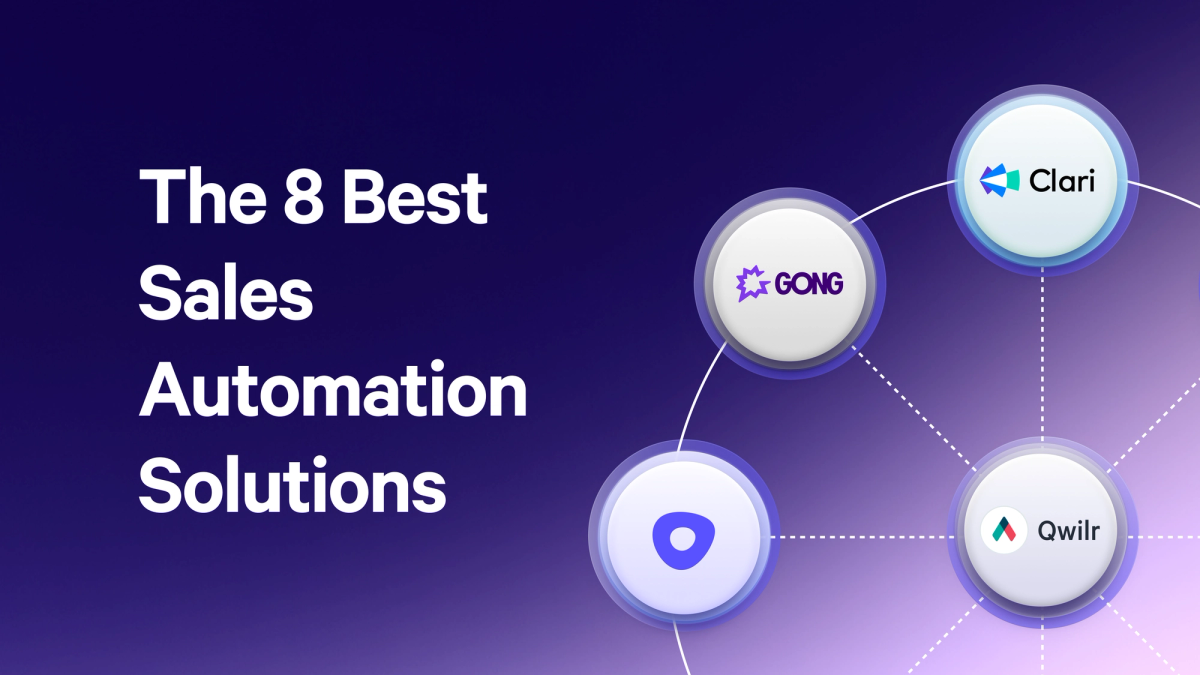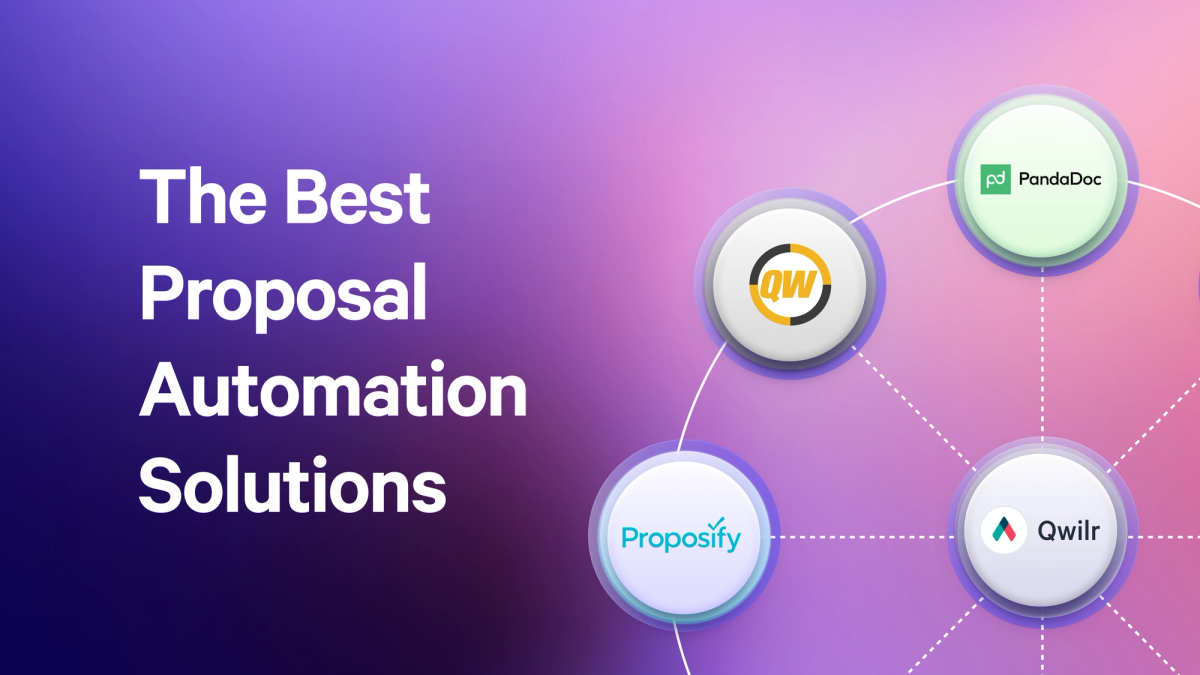When working as part of a B2B sales team, picking the best sales tools makes all the difference.
It’s a no-brainer that the sales landscape has experienced tremendous shifts in the last decade. And while the iconic door-to-door method of selling appealed to customers in the past, it’s no more “We like you, so we are going to give this product a try”.
Today sales professionals are responsible for sales prospecting, building a sales pipeline, scheduling meetings, staying on top of their revenue, retaining customers, and being able to forecast. Phew! It is indeed a juggling act.
The bottom line is quite simple— to offer value-based selling and satisfy the needs of the evolved customer, modern sales teams need to be on top of things, and that’s where sales tools come into the picture.
Sales tools can streamline your sales workflows, help your team save time on repetitive admin work (think of the zillion spreadsheets you maintain) and empower you with insights to help them sell more intelligently and bring more leads into the sales funnel.
But how do you decide which sales tools are best for your business and help you double your quotas? With so many choices, it is easy to get overwhelmed, and you may make a purchase you regret.
That’s why we’ve done the heavy lifting and evaluated 10 sales tools across categories and hand-picked the ones that will keep your team organized and ready for business.
How to choose the right sales tools
Choosing the right sales tools isn’t a straightforward decision, and besides pricing, there’s a lot to consider, especially since each sales tool on the market comes armed with unique features and services that can help your business.
The odds of choosing the wrong software are comparatively high—approximately 73%, as found in a report by Capterra.
One wrong move and you’ll be stuck with a tool that does not serve your business needs correctly depending on your use case as a start up perhaps or a larger established business. It’s not uncommon to see sales teams pick a tool without much consideration, and start training their team on the ins and outs of the new tool only to realise that it wasn’t the most fitting tool for their needs!
To avoid all this, it’s best to weigh in on a few pointers before you spend those dollars on your sales tech stack (this is after the endless meetings, research, and demos that you’ve already spent time on).
Take inputs from the key users
Even though having demos and convincing conversations with vendors may seem like the best first step, missing out on inputs from key team members or decision makers, i.e. the people who will be eventually using the said sales tool, will make the whole exercise pointless.
Ignoring key users in the decision-making process may lead to them abandoning the tool and may also come in the way of future adoption.
It’s, therefore, important to evaluate their existing pain points and see if the sales tool solves their challenges in an efficient way. They should be able to clearly envision the value the sales tool will add in increasing their productivity and performance and how it will help them reclaim the hours they spend on boring or repeated admin tasks. Lastly, it boosts their motivation to be part of the decision-making process on tools they use regularly.
Stay away from the shiny object syndrome
There’s a level of infatuation that sales leaders feel when it comes to new sales tools—the shiny object syndrome.
It’s tempting to get swayed by recommendations from industry peers, and while some may argue that it’s a legit way to stay on top of better B2B sales tools, it can be both distracting and disruptive for a business.
The argument is only valid when it justifies a need, not a want. No one wants to pay more for an unnecessary product, right?
It’s always easier to scale up as your business grows and move to a feature-rich product when you really need one. If you are still unsure, writing a business case for a software purchase may be an excellent task to remove any biases and access impact.
Choose a well-balanced sales tool
Most businesses have faced this common problem—spending a hefty amount on a software purchase, only to realise they end up using only half or less of its features.
All-in-one sales tools make a lot of sense in this context. Such tools come armed with features that target various problems and, in most cases, offer a better value for money. Such sales software also offers a subscription plan allowing you to pick more relevant features as your business grows.
Remember: The best bet is to choose a sales tool that is the closest fit for your business needs. Before making a purchase, closely evaluate features and uses cases and see how to extract the maximum value from a single product. It’s also recommended to thoroughly comb your current tech stack to see if any existing tools can offer a solution or have partner offers with another vendor that makes the purchase affordable.
That said, don’t shy away from using a mix of software if your business needs are more customized.
Think about the future
One of the primary reasons for investing in a sales tool is the ability to do things that were once manual, time-consuming, or impossible. It is important that the tool remains a good functional fit in the future or at least offers a plan that matches your evolved business needs.
Once you have gone through the above pointers, don’t stop there. Evaluate reviews, gather additional feedback from peers in the industry, revisit your sales strategy and demo again if needed to build a strong case.
Best CRM tool: HubSpot
A customer relationship management tool or CRM software helps salespeople and the companies they work for track outreach and interactions with prospects and clients manage and automate communications. It is a fundamental sales tool for any serious sales organization.
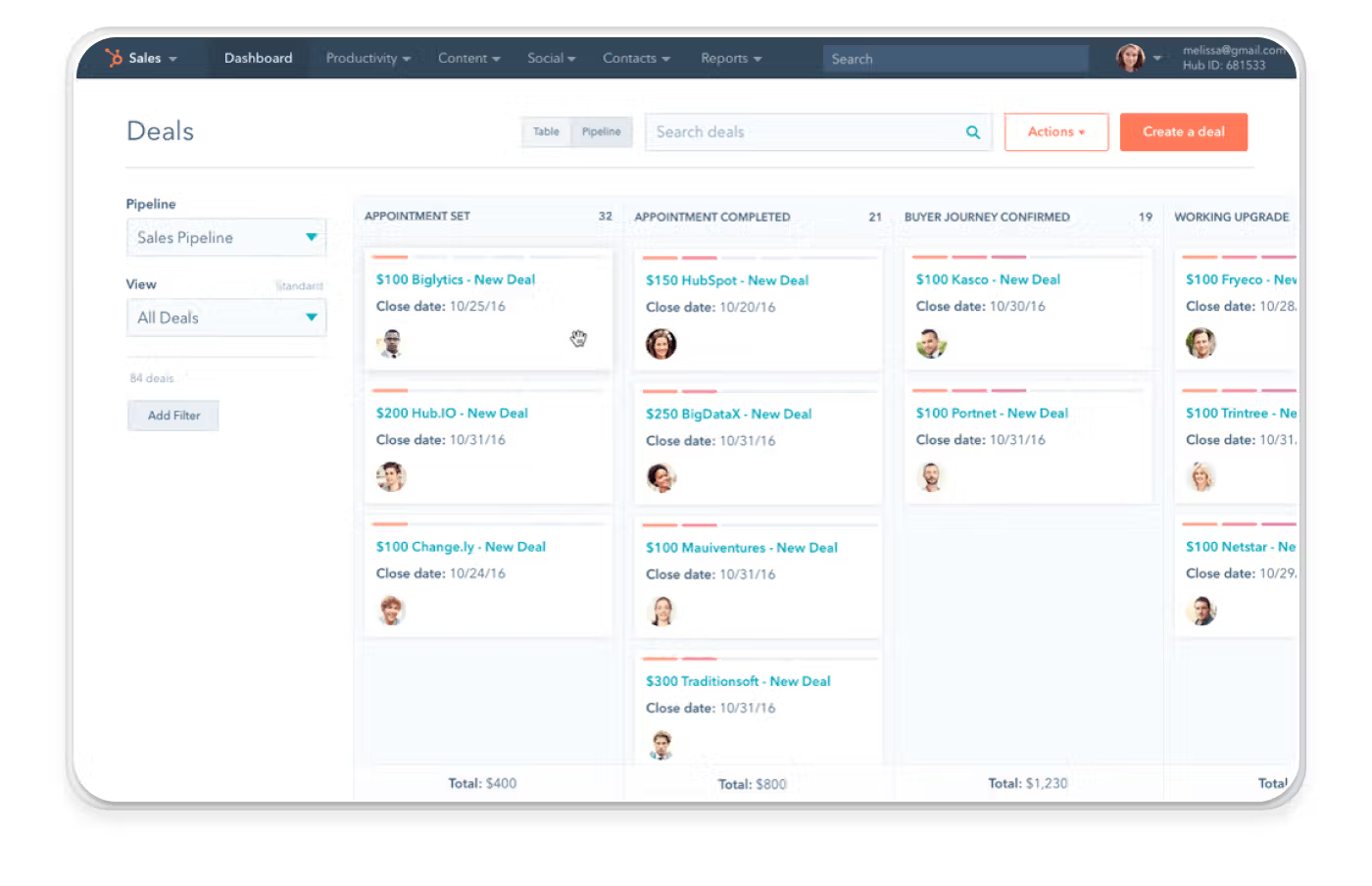
One of the most popular (and efficient) sales CRM software out there is HubSpot (shameless plug, HubSpot CRM integrates quite well with Qwilr) which offers solutions tailored for both small businesses and enterprise customers.
HubSpot CRM offers a wide variety of user-friendly features, including company insights, deal tracking, pipeline management, reporting dashboard while championing the basics, i.e. allowing sales reps and managers to track all parts of the buyer’s journey, including interactions across email, sales calls and new leads.
Free features include contact deal and task management, email tracking and engagement notifications, email templates and scheduling, document sharing, meeting scheduling, live chat and sales quotes.
- Pricing: HubSpot allows companies to access the CRM software for free for up to 1,000,000 contacts with no time limit, expiration date, or cap on the team size. Advanced CRM capabilities can be accessed through HubSpot premium Sales Hub products (prices range between $45/month to - $1,200/month based on the product tier).
- Use case: Offers valuable features for sales leaders, salespeople, marketing teams, customer service teams and operations managers.
- Accessibility: Prioritizes accessibility and is ADA-compliant.
- Templates: Yes. Offers a variety of email templates that can be personalized and optimized.
- Tracking & analytics: Yes. HubSpot CRM offers email tracking, call tracking, document management, and tracking.
- Integrations: Yes. The tool offers seamless CRM integration with over 1,340 tools in HubSpot’s App Marketplace.
- Standout feature: Automated data capture. HubSpot CRM automatically logs calls made and emails sent from the system and posts them in a timeline-like view on the contact's record page.
- Customer support: Offers 24/7 customer support across live chat, email, or phone, depending on the plan.
Best prospecting tool: Lusha
Identifying and connecting with potential customers to generate new business may seem straightforward, but it is not. Sending cold emails, zoom video conferencing with prospects, list building, consistently ensuring access to qualified leads, and closing deals is tiresome.
By adding a prospecting tool to your sales stack, you have the ability to minimize the time your team spends on mundane tasks while increasing the quota.
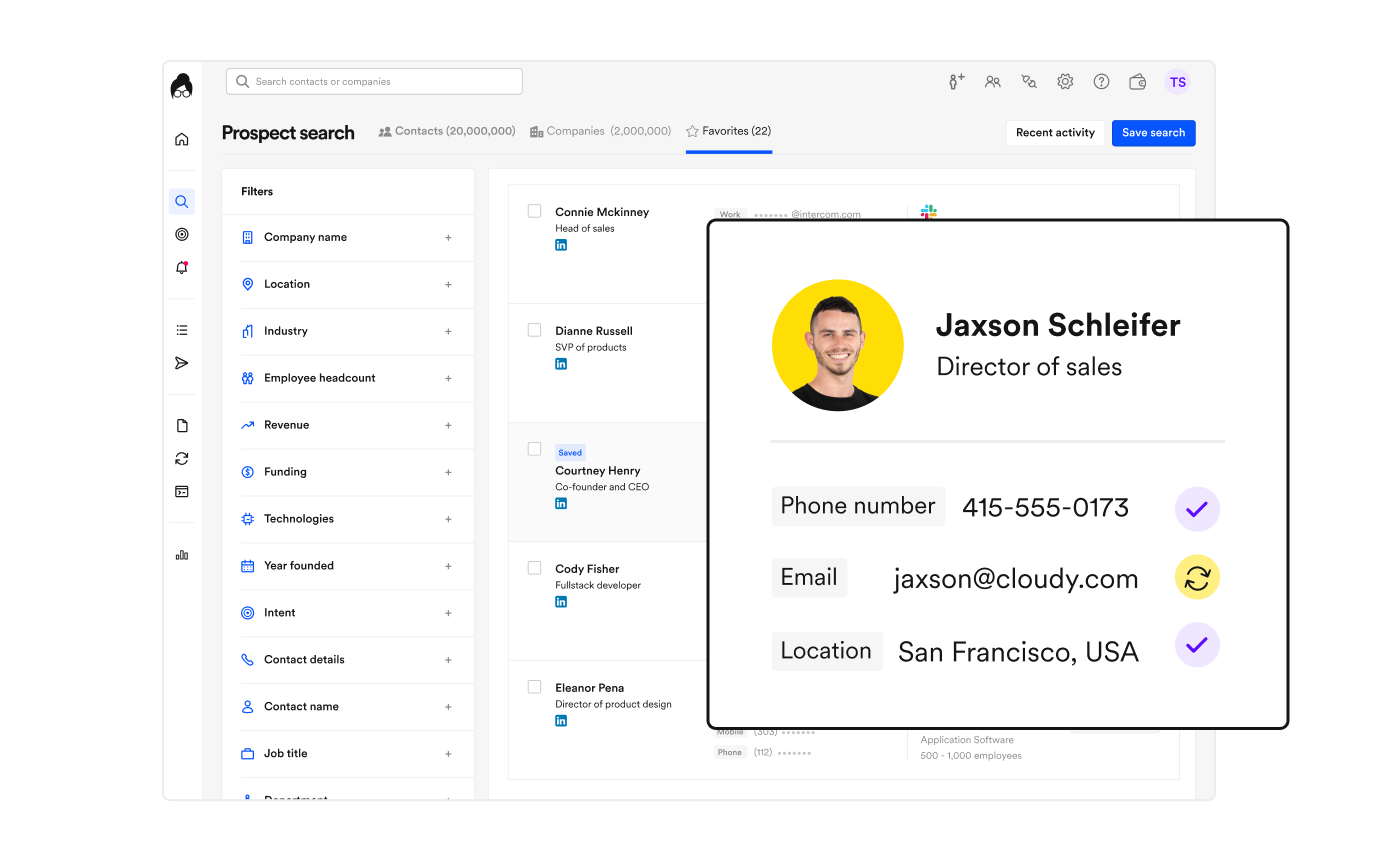
Lusha is one such cloud-based prospecting tool that allows sales teams to access a prospect’s contact information in seconds. Lusha comes powered with extensions for Gmail, Firefox, and Edge and works seamlessly with Gmail, LinkedinSales Navigator, Recruiter, Salesforce and more. Users get access to customer data such as contact search, company search, social media as well as lists.
- Pricing: The sales prospecting tool is only available on a paid plan. Lusha offers credit-based plans across Pro at $29/mo/user (40 credits), a $59/m/user (80 credits) premium, and a customized enterprise plan. Both monthly and annual payment options are available for users, and the feature varies with your plan.
- Use case: Offers valuable features for an organisation's sales, marketing and recruitment teams.
- Accessibility: No data available.
- Templates: Not available.
- Tracking & analytics: Yes, it offers actionable insights to managers to gain visibility on the team’s prospecting.
- Integrations: The extension allows one-click integration with HubSpot and Salesforce CRM from within the platform and many other sales tools.
- Standout feature: Lusha lets user access compliant data under its Lusha's 7 Trust-Filters™—a 7-step data verification system.
- Customer support: Offers support through chat and help documentation.
Best lead generation tool: Clearbit
It’s safe to say that the biggest challenge for sales teams isn’t closing leads— it’s actually finding more. If your team doesn’t have a robust process for attaining quality leads your sales machinery will be impacted.
A lead generation tool empowers busy sales teams to feed their pipeline constantly. However, the process of prospecting needs to be automated so that your team does not waste time on manual lead scoring. This will ensure that what you get are prospects that match your ideal customer profile (ICP).
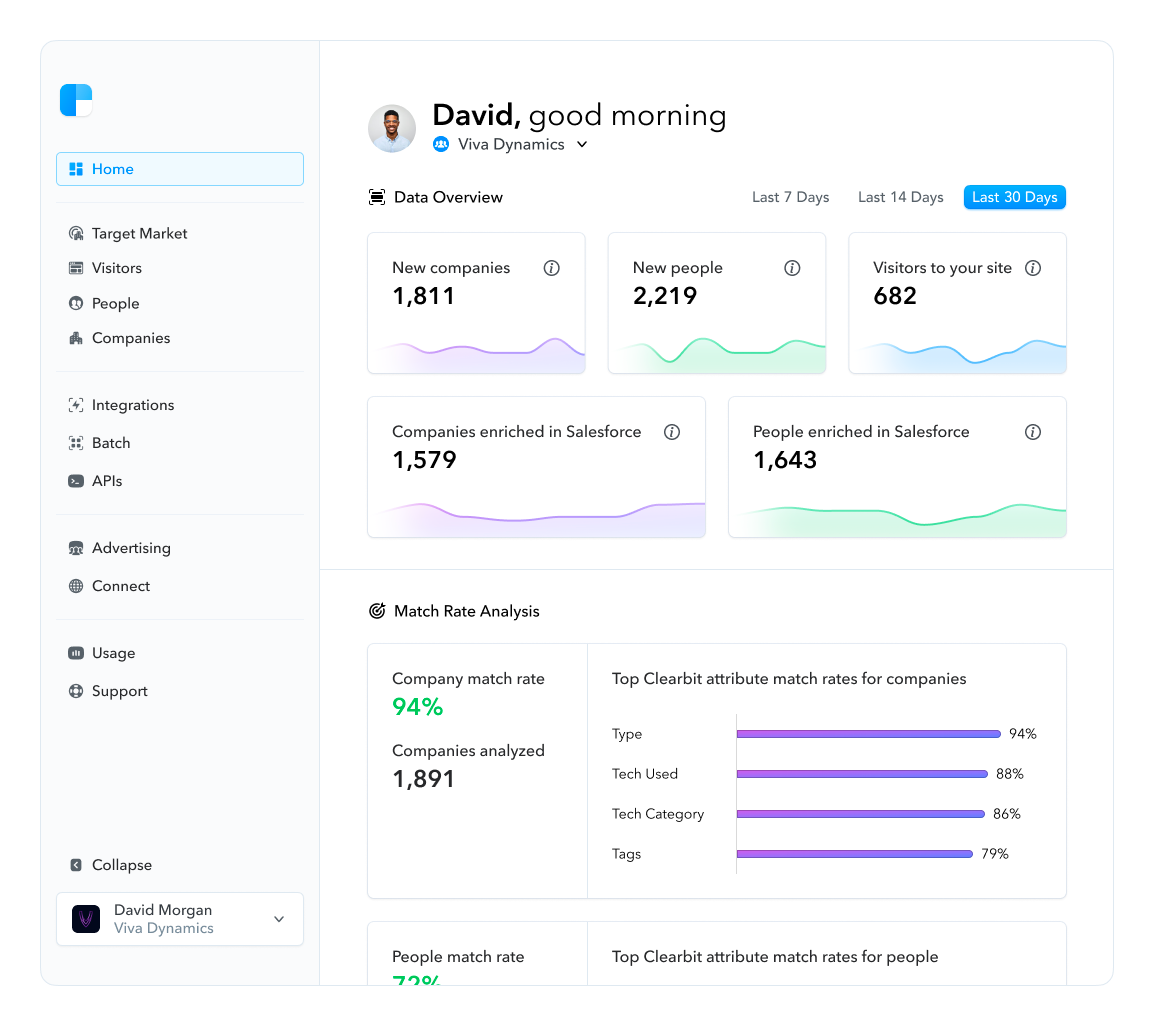
Clearbit helps solves this for time-poor sales teams with its form optimization tool, thus boosting sales productivity. The tool offers form autofill and dynamic shortening to ensure 100% data capture. With just an email, the tool pulls over job titles, industries, locations, company size, and technologies, making the data much more accurate. Clearbit also offers a variety of marketing solutions ranging from demand generation, lead generation, lead management and conversion, making it an ideal addition to your sales stack.
- Pricing: Clearbit offers customized pricing. Contact the team for a custom quote.
- Use case: Has features for Marketing, Operations, Sales and Product teams.
- Accessibility: Not enough information on accessibility.
- Templates: Not applicable to this tool.
- Tracking & analytics: Yes. Offers a weekly visitor report powered by Clearbit IP Intelligence platform.
- Integrations: Offers integrations with a wide variety of CRM and sales tools such as Salesforce, Marketo, Segment and more.
- Standout feature: Real-time data enrichment with instant account info and complete records.
- Customer support: Customer support is available via the help center and email.
Best proposal tool: Qwilr
As every salesperson knows— at least those who had to plod through the preparation of proposals the old way— the proposal process can consume a lot of time, slow down the sales cycle, and in some cases, even result in losing a deal. A quality proposal management fixes all that— and more.
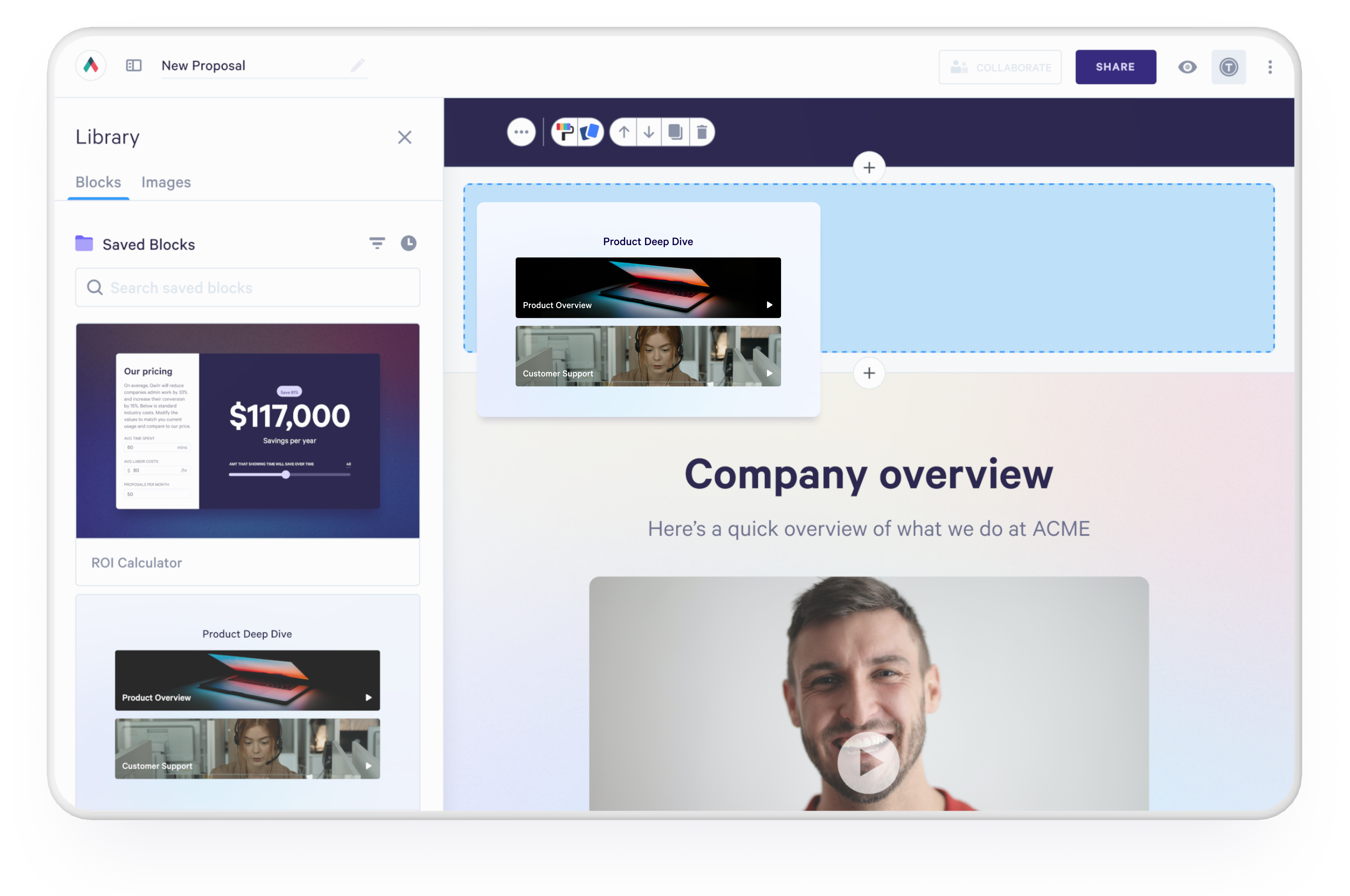
Today’s quote and proposal software isn’t just functional— it also enables sellers to create beautiful, personalized, and interactive proposals without needing a designer. Whether you’re a start-up SaaS company or a large enterprise organization, quote software can help a team scale, improve sales efficiency, and increase closed/won rates. If you create proposals of any kind, chances are good that you could benefit from quote and proposal software.
Qwilr offers the sales team user-friendly and robust proposal automation software that helps them customize and create impressive sales content. Sales proposals created using Qwilr are visually stunning and can be customized with your own brand colours and fonts, and have easy drag-and-drop design options. But that’s not all. Qwilr offers analytics functionality that gives real-time insights into your buyer’s behaviours, native esignature, plus, an ever-growing template library that has carefully crafted enterprise sales templates and more, making it easier for anyone to create winning sales proposals from scratch.
- Pricing: Qwilr offers business and enterprise plans starting at USD $35, with a 14-day free trial.
- Use case: Qwilr can be used by sales, marketing, sales ops, customer success and recruitment teams.
- Accessibility: All proposals and sales collateral created is mobile and desktop compatible.
- Templates: Yes, Qwilr offers over 100+ professional proposal templates such as SaaS and marketing proposals.
- Tracking & analytics: Users can see who engaged with their content and what they looked at when clicking.
- Integrations: Qwilr easily integrates with various sales software across the board.
- Standout feature: Automated content helps the sales team create content on the go.
- Customer support: 24/7 customer support on weekdays with limited support on weekends and holidays.
Best sales automation tool: Zendesk Sell
The benefits of automating a sales process cannot be stressed enough. Every task that can be automated gives the sales team enough space to wiggle and focus on what matters the most — landing high ticket deals, closing sales, making quota and doubling your sales activities.
Sales automation software streamlines the above to happen. In a nutshell, sales automation tools assist in streamlining repetitive tasks, improving productivity, accelerating the sales process, and reducing costs.
Unlike a feature-specific automation tool, Zendesk Sell is an all-in-one sales automation platform offering solutions for SMBs and enterprise customers. The tool gives complete pipeline visibility, helps capture the right data, and offers personalized conversational experiences, which in turn enhances customer experience.
- Pricing: Pricing starts at US $19/ per month and goes up to US $150 for the enterprise plan.
- Use case: Zendesk Sell is most apt for the sales team, but the wider software also offers use cases for CX teams.
- Accessibility: Yes. Zendesk is disability friendly.
- Templates: Yes. Offers smart lists and templates for easy use.
- Tracking & analytics: Yes. Offers forecasting, pipeline analysis, advanced analytics, and pre-built dashboards to view them.
- Integrations: Zendesk Sell offers email integration and additional integrations through its marketplace.
- Standout feature: A Power feature dialer that helps your team create an automatically dialed list—all through a unique phone number.
- Customer support: Support is available via live chat, community, help center or from within the account.
Best sales intelligence tool: Apollo
Sales leaders are always looking for predictability, yet one of the common issues that they battle is unpredictable sales data. How many prospects will convert into customers, what value propositions will ignite their interest or knowing exactly who is responsible for making a decision—there isn’t a set playbook that one can follow.
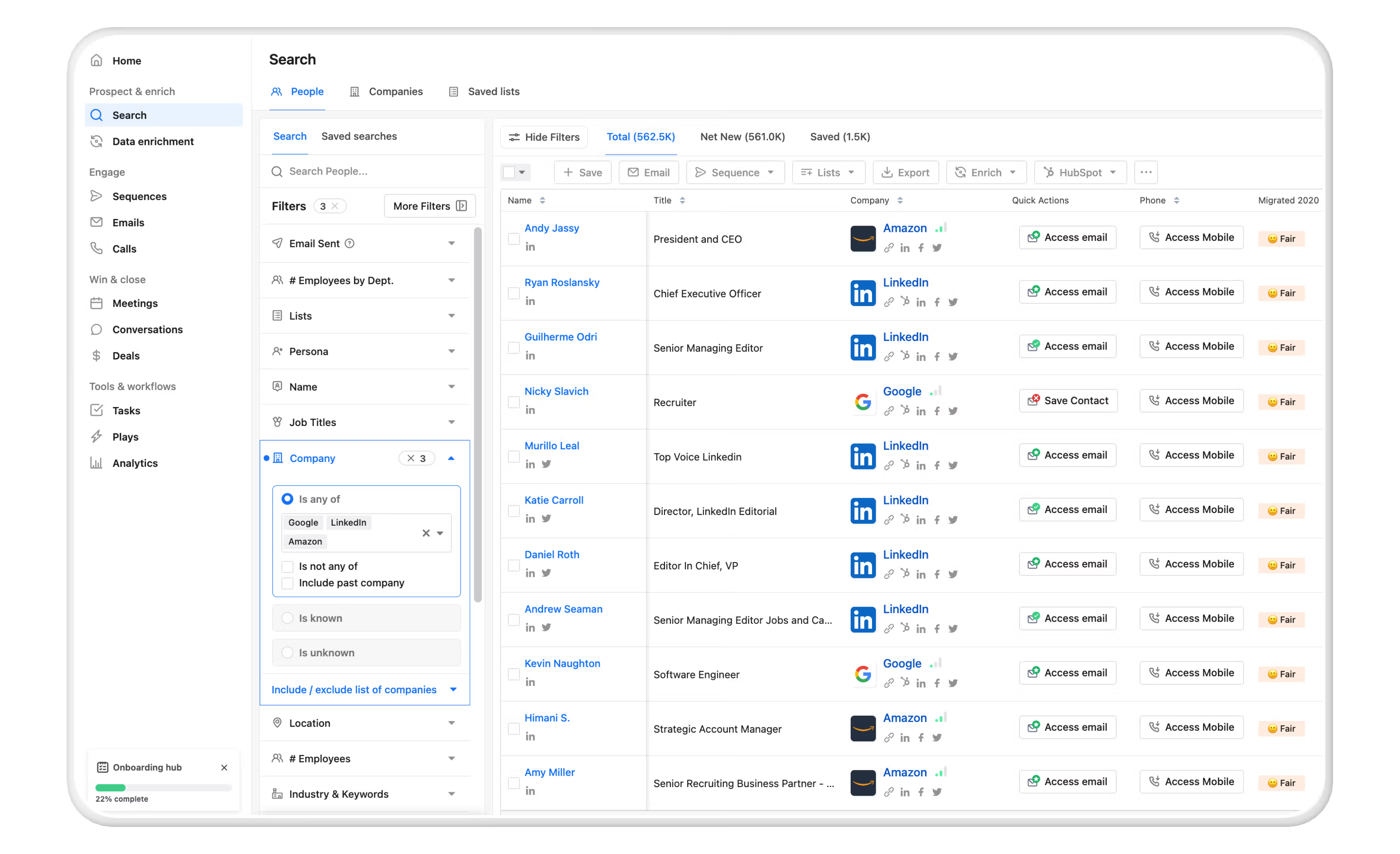
If your organization is facing a similar problem, you can rely on sales intelligence tools. Apart from the regular data touch points such as name, email, company info, job title, and seniority, sales intelligence tools can also help with powerful insights, sales triggers, and intent data, allowing you to do more data-driven prospecting.
Apollo.io’s sales intelligence tool comes armed with 200+ attributes and Ai prospecting, making it one of the best sales intelligence tools in the market.
- Pricing: The Basic plan starts at $49/per user/month and goes up to $99 for a professional plan. A free plan is also available with unlimited email credits but limited functionality.
- Use case: Solutions available for sales, marketing and founders.
- Accessibility: Not enough information on accessibility.
- Templates: Yes, offers templates as part of sequences.
- Tracking & analytics: Offers sales engagement analytics.
- Integrations: Integrates with the most popular sales platforms and CRM. Comes with a Chrome extension.
- Standout feature: Direct addition to a sequence through Linkedin.
- Customer support: Customer support via email.
Best sales engagement tool: Outreach
Sales engagement is key to the success of your team closing deals quickly. Such tools help you simplify your sales outreach by organizing your team’s daily activities and tasks, gathering customer insights, automating email sends, follow up and more.
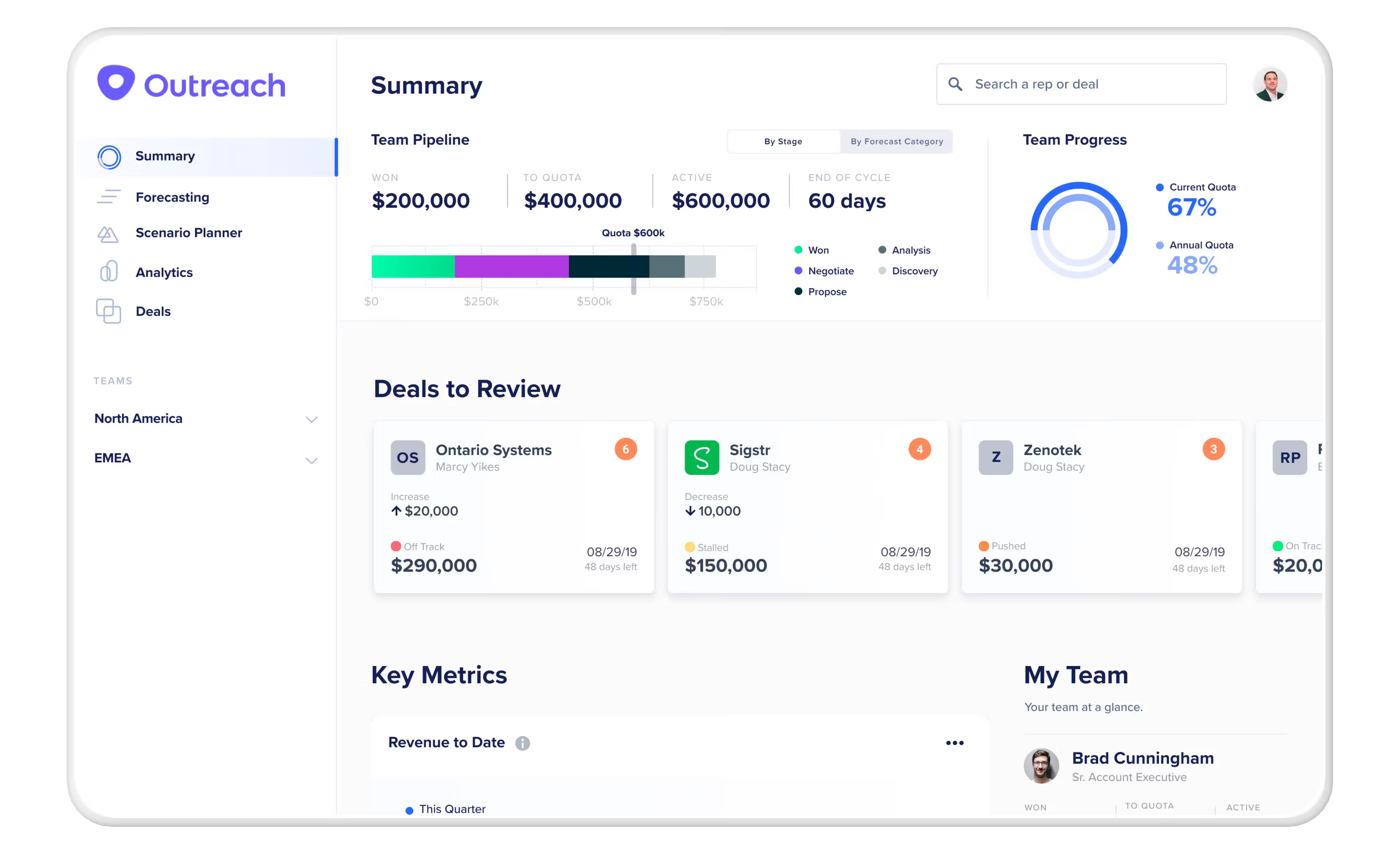
Outreach, a sales engagement tool, offers users capabilities such as lead follow-up and personalized messaging. It helps improve overall prospecting by building a high-quality pipeline through advanced sequence capabilities. But that’s just the tip of the iceberg. Outreach comes armed with powerful features such as sentiment analysis, OOO detection and integrated A/B testing.
- Pricing: Reach out to the team for custom pricing.
- Use case: Sales team (reps, leadership, development and leaders).
- Accessibility: Not enough information on accessibility.
- Templates: Yes, it does offer templates for regular use in sequence and other emails.
- Tracking & analytics: It offers AI-rich insights helping managers understand what action leads to sales.
- Integrations: Yes, it integrates with a wide variety of sales tools.
- Standout feature: Machine-learning-driven A/B testing, buyer sentiment analysis, and sequence insights for sales reps.
- Customer support: Offers support via a self-service portal, tickets, chat and live support based on the plan.
Best contract management tool: Juro
Whatever the nature of your business, having powerful contracts protects the interests of every party involved. Contracts help strengthen service-level agreements and ensure that all aspects of the deal comply with the company’s laws and regulations.
While one may not look at contract management software as a typical sales tool, it is a key part of any sales stack and helps create, store, manage and share complex business contracts.
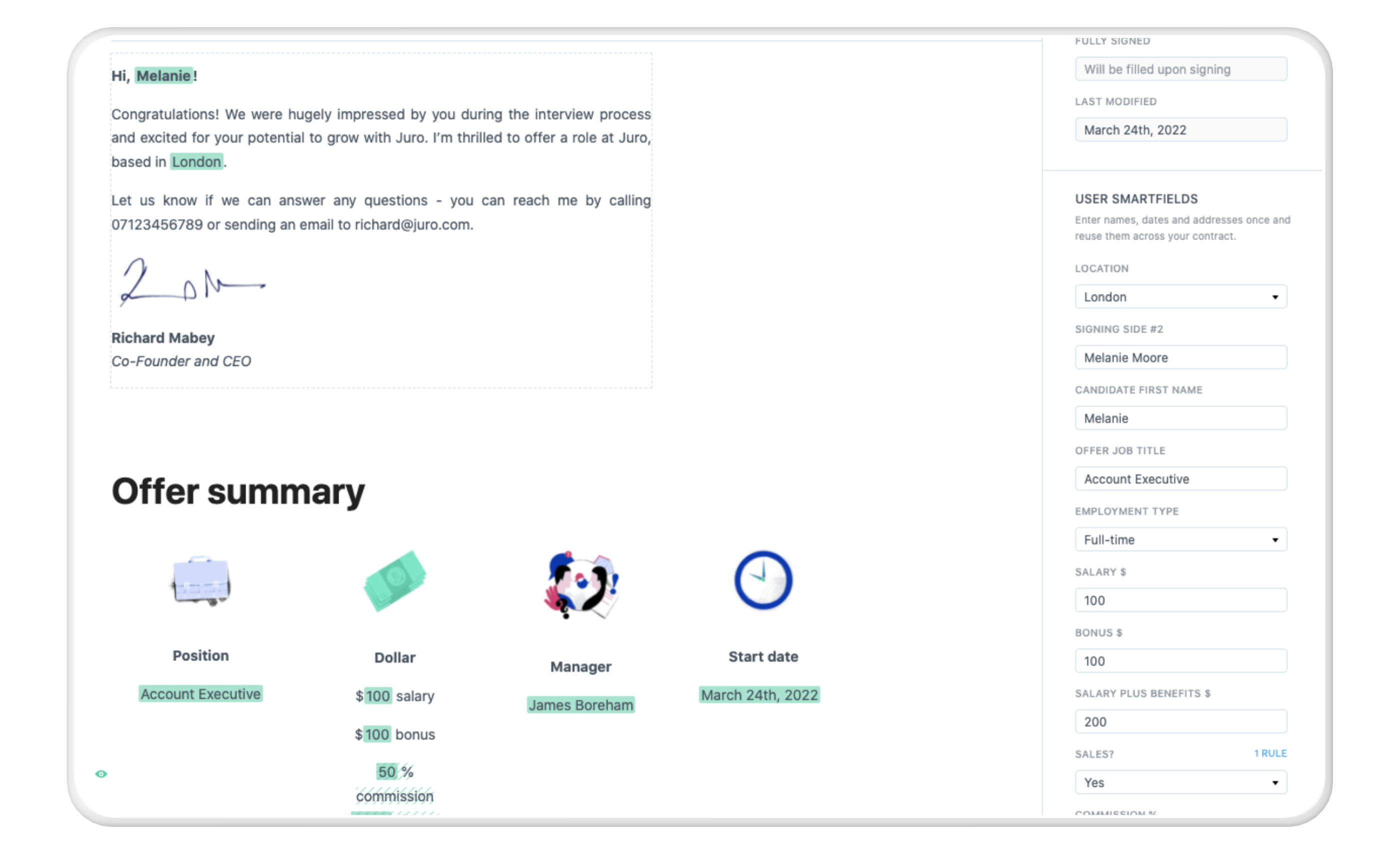
Juro’s all-in-one contract management software makes the entire process of creating, negotiating and signing a contract effortless. The software also allows you to track contracts and integrates contract workflow with core platforms.
- Pricing: Offers three pricing tiers. Reach out to the team for custom pricing.
- Use case: Juro can be used by legal, sales, finance & ops, and HR teams for contracts.
- Accessibility: Not enough information on accessibility.
- Templates: Easy-to-use contract templates.
- Tracking & analytics: Tracking in the form of automatic contract reminders.
- Integrations: Juro integrates with various tools such as HubSpot, Salesforce, Zapier, etc.
- Standout feature: Contract negotiation from within the platform with a browser native editor.
- Customer support: Support is available via the help center.
Best e-signature tool: Qwilr
Without a signature, a deal isn’t a deal! And in a world where everything is digital, e-signatures are the best bet to accelerate a closed deal.
Electronic signatures, or E-signature as they are widely known, offer a variety of benefits to organizations. They are widely used because of their ease of use, tracking capabilities, security, and not to forget the environmental benefits it offers over wet signatures.
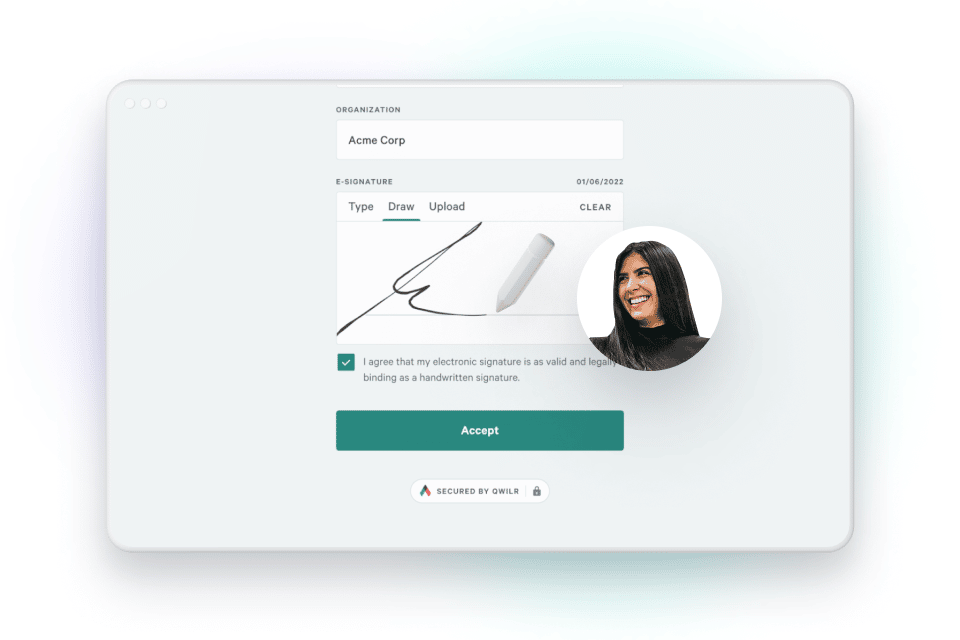
Unlike other tools in the market, Qwilr offers world-class e-signature capabilities to sales teams. Its in-built capabilities empower them to combine sales messages, quotes and e-signature from within the same document without needing any other tool. All this while maintaining legal compliance and security and integrating directly with other sales tools. Qwilr also offers an audit trail allowing you to keep a record of documents signed electronically.
- Pricing: Qwilr offers business and enterprise e signature plans starting at USD $35, with a 14-day free trial.
- Use case: Qwilr can be used by sales, marketing, sales ops, customer success and recruitment.
- Accessibility:
- Templates: Not applicable with e-signature but available as part of the tool.
- Tracking & analytics: Yes. Tracking via audit trails is available for users.
- Integrations: Qwilr easily integrates with various sales software across the board.
- Standout feature: Qwilr’s e-signature tool has an in-built feature to add customized disclaimers.
- Customer support: 24/7 customer support on weekdays with limited support on weekends and holidays.
Best account-based marketing tool: 6sense
Casting a wider net is a concept prevalent with sales teams—the idea is to get as many inbound leads as possible in one go. While this is often sensible, it also adds a massive list of unqualified leads to the pipeline, which in turn leads to wasted time and effort.
Account-based marketing tools solve the problem of removing unqualified leads by targeting the company's most valuable and best-fit clients. Your sales team then focuses on accounts that ultimately fit your company best—it’s a win-win.
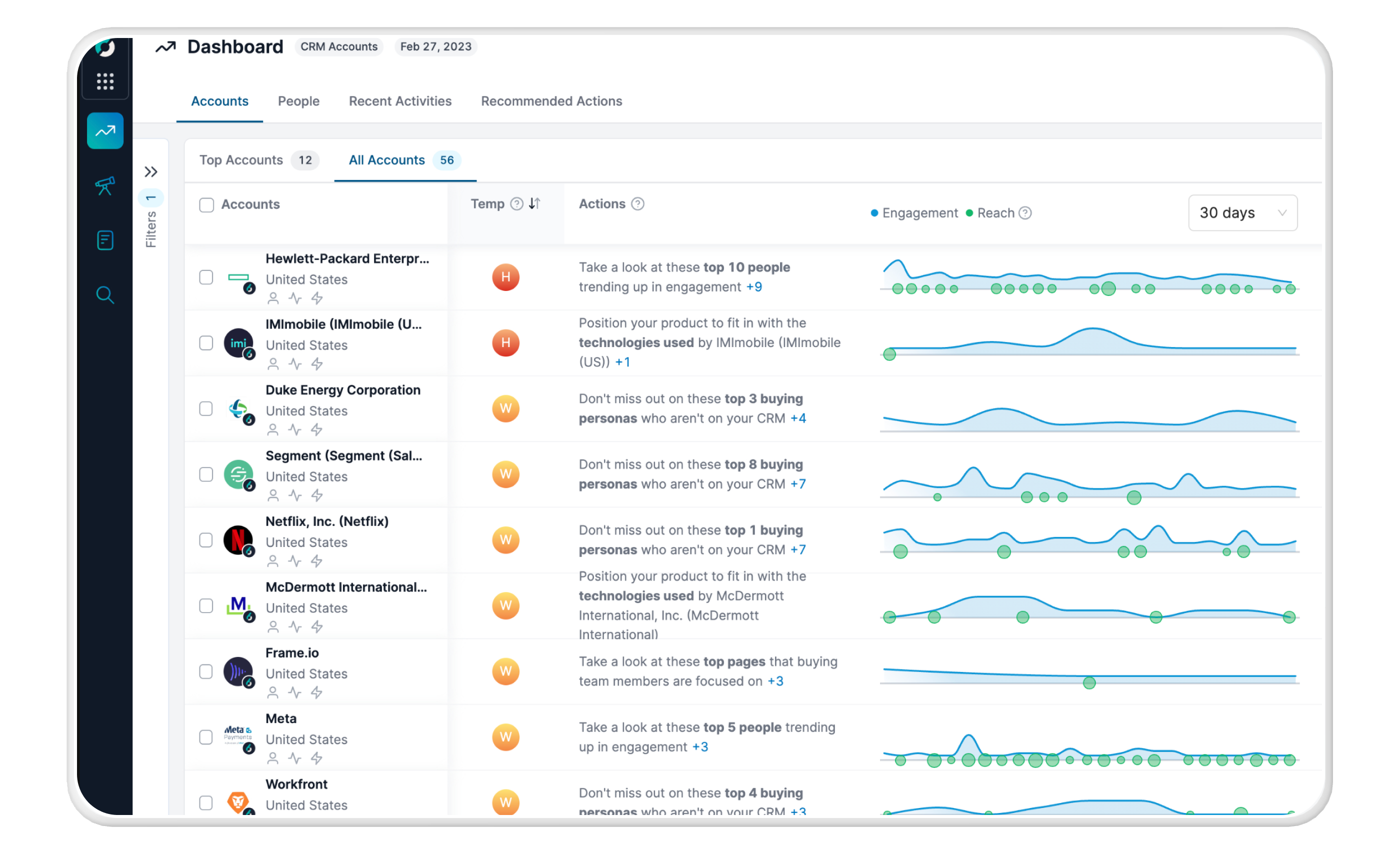
6Sense is one of the best sales tools for account-based marketing. It allows sales teams to tailor all communications, content and campaigns to key accounts, thereby improving pipeline quality and increasing conversion rates. ABM tools also help in better sales and marketing alignment within organizations, thereby improving the overall buying experience for the customer.
- Pricing: Pricing works on credits. Reach out to the team for custom pricing.
- Use case: Used by marketing ( CMO, Demand Gen, Digital) and sales teams (CRO, RevOps, Inside sales)
- Accessibility: Not enough information on accessibility.
- Templates: AI Email Assistant that replaces templates.
- Tracking & analytics: Yes. Offers tracking and analytics via prioritization dashboards.
- Integrations: Yes. 6Sense integrates with a wide variety of sales and marketing tools.
- Standout feature: AI-driven predictive analytics for sales teams.
- Customer support: 24/7 help and support are available.
Best cold outreach platform: Hunter.io
Cold outreach is a critical component of sales, but it can be challenging to identify the right contacts, verify their information, and manage personalized campaigns efficiently. Hunter.io addresses these challenges by offering an all-in-one platform that streamlines the entire outreach process.
Hunter.io enables sales teams to efficiently discover and connect with potential leads through a suite of integrated tools.

The Discover feature allows users to identify companies that match their ideal customer profile by applying filters such as industry, location, company size, technologies used, and specific keywords. This segmentation facilitates targeted B2B lead generation, enabling sales teams to focus their outreach on the most relevant prospects.
With Domain Search, users can find all email addresses associated with a specific company domain, while the Email Finder helps locate a professional's email address using their name and company. The Email Verifier ensures the deliverability of email addresses to reduce bounce rates. Finally, the Campaigns tool allows for the creation and management of personalized cold email campaigns directly within the platform.
- Pricing: Hunter.io offers a free plan with limited features and credits. Paid plans start at $49/month for the Starter plan, offering 1,000 monthly searches. The Growth plan is priced at $149/month with 5,000 searches, and the Scale plan is $299/month for 20,000 searches. Annual billing options are available with a 30% discount. Also, there is a Data Platform plan that is ideal for businesses that will only use Hunter’s data. The pricing is flexible and depends on the usage.
- Use case: Ideal for sales, marketing, and recruitment teams seeking to enhance their outreach efforts.
- Accessibility: Hunter.io is a web-based platform with Chrome and Firefox extensions available.Templates: Offers customizable email templates to streamline campaign creation.Tracking & analytics: Provides insights into email opens, clicks, bounce rates, and replies to monitor campaign performance. You can track the performance on a campaign, email account, or team member level.Integrations: Supports integrations with CRMs like HubSpot and Salesforce, as well as automation tools like Zapier.
- Standout feature: Hunter.io's Discover feature allows users to generate B2B leads at scale by filtering companies based on industry, location, company size, technologies used, and more, helping sales teams efficiently identify and target their ideal customer profiles.
- Customer support: Offers support through email and a comprehensive help center with detailed articles and guides. Many users share great thoughts about their support team.
Building an effective sales tech stack
While individual sales tools can significantly enhance specific areas of your sales process, it's crucial to remember that no tool operates in isolation.
For a truly efficient and seamless sales operation, it's vital to consider:
- How tools work together: Are there any noticeable inefficiencies when using two or more tools simultaneously?
- How to minimize capability gaps that may hinder sales effectiveness: For instance, some CRMs work better with sales engagement tools like Outreach. Whenever possible, it's beneficial to map out as much of your tech stack as you can prior to purchasing and vendor negotiations. However, starting with a blank slate may not always be feasible. In such cases, speaking with other customers of potential vendors can help navigate the nuances of the evolving tools in your stack.
- Sequencing of purchases and implementation: Some solutions may require heavy involvement from sales operations, sellers, or marketing teams. Engaging in conversations with vendors about what's required during the evaluation and implementation stages can help avoid disruptions to your sales motion and effectively manage team energy.
Interested in learning more about choosing the right sales enablement software? Check out our dedicated guide on the best sales enablement solutions.
FAQs
What is the most important sales tool?
There is no single "most important" sales tool, as the best tool for your team will depend on your specific sales process and needs. For some, it may be CRM software. For others, it may be a conversion intelligence tool or a sales productivity tool.
However, when choosing one for your sales team, it’s prudent to give importance to sales tools that solve key business problems for your sales team. They should be easy to adapt, have features that benefit your team instantly and are priced within your budget.
What tools do you need to be successful in sales?
To succeed in sales, you'll need a combination of tools to help you manage your pipeline, communicate effectively with prospects, and analyze your performance. These can range from more popular CRM, sales enablement and analytics tools to more advanced tools such as sales mapping and marketing automation tools.
When picking sales tools, it’s important to consider tools that integrate with each other to create a seamless sales ecosystem.
Scaling sales with the right sales tools
Choosing the right sales software is never easy— in most cases, a boardroom full of people needs convincing before you even sign a deal.
But they are important. They help sales teams to be more effective. From reducing manual processes to increasing account intelligence to improving sales predictability, sales technology helps salespeople and sales managers improve what they do. Whether your goal is to accelerate growth, optimize sales outcomes, or scale your team, an investment in the right sales tools gives your organization the foundation to succeed.
Curious how Qwilr sales proposals can help your team save time, stand out, and win more business? In just 15 minutes, we’ll show you how – book a free demo today.
About the author

Brendan Connaughton|Head of Growth Marketing
Brendan heads up growth marketing and demand generation at Qwilr, overseeing performance marketing, SEO, and lifecycle initiatives. Brendan has been instrumental in developing go-to-market functions for a number of high-growth startups and challenger brands.

